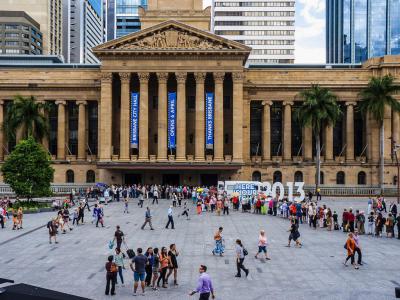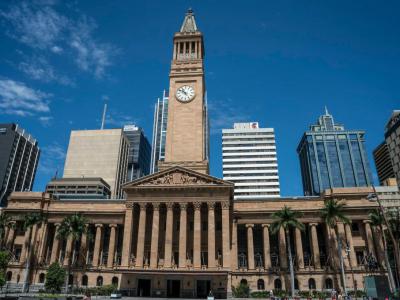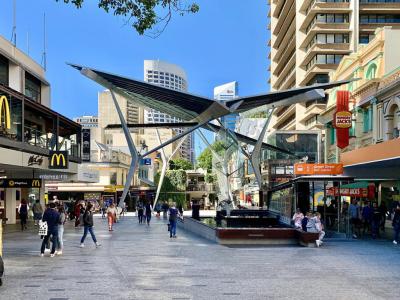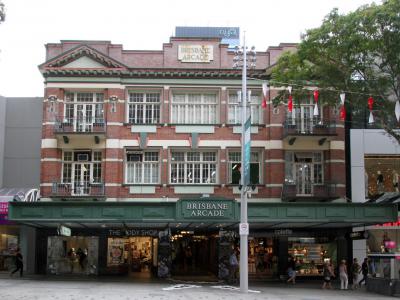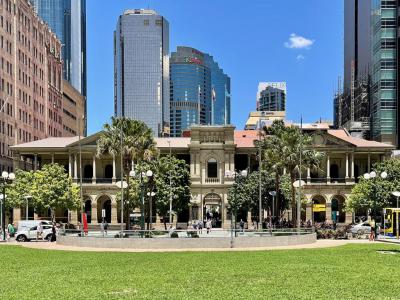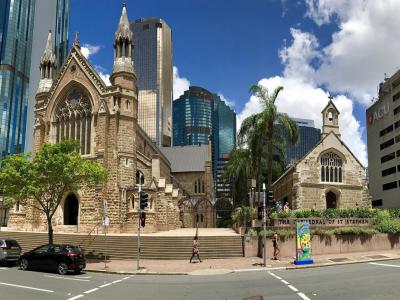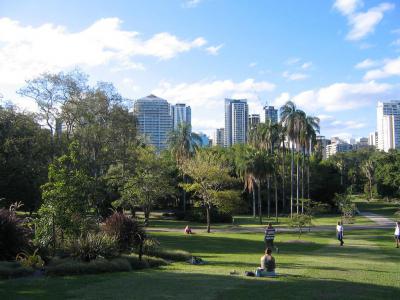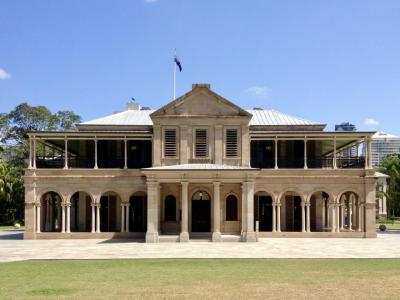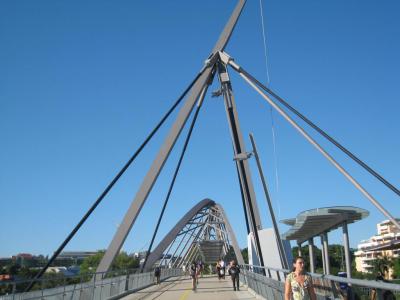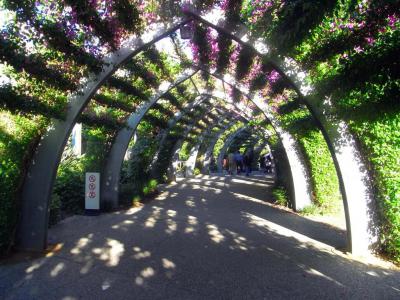
Brisbane Introduction Walking Tour (Self Guided), Brisbane
Brisbane, the capital of Queensland, is a large metropolis, the third-most populous in Australia after Sydney and Melbourne. Aboriginal Australians have inhabited this area for at least 22,000 years; their estimated population by the time the European settlers arrived in the 1820s had reached between 6,000 and 10,000.
The city is named for the Brisbane River that it straddles, which in turn was named after Sir Thomas Brisbane, the then governor of New South Wales. The city was founded in 1824, first as a penal settlement for secondary offenders from the Sydney colony. Following the arrival of Christian missionaries, the region opened to free settlement in 1842.
Brisbane was chosen as the capital of Queensland when the latter separated from New South Wales in 1859, and by the late 19th century had grown into a major port city and centre of immigration.
Today's Brisbane is a major transportation hub and a popular destination for international tourism. Its modern nicknames include "Brissie" and the "River City", the latter being for the Brisbane River meandering through the city centre en route to the azure Moreton Bay, largely complementing the modern high-rise architecture and lush greenery. Looming over the city is Mt. Coot-tha, the site of Brisbane Botanic Gardens.
Among other local landmarks there are many sights of historical, cultural and architectural importance, such as:
King George Square – a regional heritage object since 2004; home to many public events and open-air markets, as well as, most importantly, the Brisbane City Hall - one of the most ornate and beautiful of Australia’s city halls; dating to the 1930s. The building's third floor houses the Museum of Brisbane;
Queen Street Mall – the hustle and bustle of Brisbane’s Central Business District centers on this huge pedestrian shopping venue, the city’s predominant retail space;
Brisbane Arcade – another major shopping venue, located in a charming historical building;
General Post Office Building – one more cute historical edifice, open since 1872;
Cathedral of St. Stephen – a Gothic Revival temple that took over a century to build, from 1863 to 1989;
Old Government House – one of the oldest buildings in Brisbane, erected in 1862;
Goodwill Bridge – a pedestrian bridge over the Brisbane River; acts as both transportation facility and a work of art.
For a closer acquaintance with these and other prominent attractions of Brisbane, take this self-guided introductory walk!
The city is named for the Brisbane River that it straddles, which in turn was named after Sir Thomas Brisbane, the then governor of New South Wales. The city was founded in 1824, first as a penal settlement for secondary offenders from the Sydney colony. Following the arrival of Christian missionaries, the region opened to free settlement in 1842.
Brisbane was chosen as the capital of Queensland when the latter separated from New South Wales in 1859, and by the late 19th century had grown into a major port city and centre of immigration.
Today's Brisbane is a major transportation hub and a popular destination for international tourism. Its modern nicknames include "Brissie" and the "River City", the latter being for the Brisbane River meandering through the city centre en route to the azure Moreton Bay, largely complementing the modern high-rise architecture and lush greenery. Looming over the city is Mt. Coot-tha, the site of Brisbane Botanic Gardens.
Among other local landmarks there are many sights of historical, cultural and architectural importance, such as:
King George Square – a regional heritage object since 2004; home to many public events and open-air markets, as well as, most importantly, the Brisbane City Hall - one of the most ornate and beautiful of Australia’s city halls; dating to the 1930s. The building's third floor houses the Museum of Brisbane;
Queen Street Mall – the hustle and bustle of Brisbane’s Central Business District centers on this huge pedestrian shopping venue, the city’s predominant retail space;
Brisbane Arcade – another major shopping venue, located in a charming historical building;
General Post Office Building – one more cute historical edifice, open since 1872;
Cathedral of St. Stephen – a Gothic Revival temple that took over a century to build, from 1863 to 1989;
Old Government House – one of the oldest buildings in Brisbane, erected in 1862;
Goodwill Bridge – a pedestrian bridge over the Brisbane River; acts as both transportation facility and a work of art.
For a closer acquaintance with these and other prominent attractions of Brisbane, take this self-guided introductory walk!
How it works: Download the app "GPSmyCity: Walks in 1K+ Cities" from Apple App Store or Google Play Store to your mobile phone or tablet. The app turns your mobile device into a personal tour guide and its built-in GPS navigation functions guide you from one tour stop to next. The app works offline, so no data plan is needed when traveling abroad.
Brisbane Introduction Walking Tour Map
Guide Name: Brisbane Introduction Walking Tour
Guide Location: Australia » Brisbane (See other walking tours in Brisbane)
Guide Type: Self-guided Walking Tour (Sightseeing)
# of Attractions: 11
Tour Duration: 2 Hour(s)
Travel Distance: 3.5 Km or 2.2 Miles
Author: gene
Sight(s) Featured in This Guide:
Guide Location: Australia » Brisbane (See other walking tours in Brisbane)
Guide Type: Self-guided Walking Tour (Sightseeing)
# of Attractions: 11
Tour Duration: 2 Hour(s)
Travel Distance: 3.5 Km or 2.2 Miles
Author: gene
Sight(s) Featured in This Guide:
- King George Square
- Brisbane City Hall and Museum of Brisbane
- Queen Street Mall
- Brisbane Arcade
- General Post Office Building
- Cathedral of St. Stephen
- City Botanic Gardens
- Old Government House
- Goodwill Bridge
- South Bank Grand Arbour
- South Bank Parklands
1) King George Square
King George Square is a public square in Brisbane that dates to the early 20th century. Originally called Market Square and renamed for Britain's Prince Albert, the square is now named in honor of King George V. It is a location for many public events, festivals and open-air markets.
The original square fell between Albert, Ann and Adelaide Streets. It was chosen as the location of the Brisbane City Hall, which caused the square to be expanded. City planners widened the square once again after the death of King George V.
The expansion added a number sculptures and a rectangular fountain. Some of these sculptures in King George Square include King George V, Steele Rudd, Emma Miller, Sir Charles Lilley and bronze lions that guard the entrance.
Visitors to the city can easily walk through the square without interruption as it is closed to street traffic. Due to its central location, the square is a good starting point for a walking tour. It is a short walk to most of central Brisbane's most visited tourist spots.
King George Square was added to the Brisbane Heritage Register in 2004.
The original square fell between Albert, Ann and Adelaide Streets. It was chosen as the location of the Brisbane City Hall, which caused the square to be expanded. City planners widened the square once again after the death of King George V.
The expansion added a number sculptures and a rectangular fountain. Some of these sculptures in King George Square include King George V, Steele Rudd, Emma Miller, Sir Charles Lilley and bronze lions that guard the entrance.
Visitors to the city can easily walk through the square without interruption as it is closed to street traffic. Due to its central location, the square is a good starting point for a walking tour. It is a short walk to most of central Brisbane's most visited tourist spots.
King George Square was added to the Brisbane Heritage Register in 2004.
2) Brisbane City Hall and Museum of Brisbane
Brisbane City Hall is located in King George Square. The building is widely considered to be one of the most ornate and beautiful of Australia’s city halls. The foundation stone of the building was laid in 1920 and construction was completed by 1930. For many years the hall was Brisbane’s tallest building and to this day you can take the elevator to the top of the clock tower and get an impressive panoramic view over the city. The viewing platform is open 10am to 3pm every day, and there is no admission fee. The clock tower is 91 meters above the ground and was inspired by Saint Mark’s Campanile in Venice, Italy.
Built in the Italian Renaissance style, there is much to see in the building. Above the Corinthian columns at the entrance to the building is the ornately carved tympanum, which was carved by Sculptor Daphne Mayo in the 1930s. It features scenes of the settlement of Queensland with cattle drovers extending out into the lands filled with kangaroos. Inside there are many beautiful rooms, but the highlight is the main auditorium inspired by the Pantheon in Rome.
On the city hall's third floor, you will find the Museum of Brisbane which is dedicated to showcase the different facets, historical and contemporary, of this sub-tropical state capital city. You will find fascinating displays of all aspects of the city. The ethos of the museum is to guide visitors towards developing an understanding of Brisbane’s people and communities and how they have worked together to create the city that you see today. It also encourages visitors to envisage the city that will become in the future.
Built in the Italian Renaissance style, there is much to see in the building. Above the Corinthian columns at the entrance to the building is the ornately carved tympanum, which was carved by Sculptor Daphne Mayo in the 1930s. It features scenes of the settlement of Queensland with cattle drovers extending out into the lands filled with kangaroos. Inside there are many beautiful rooms, but the highlight is the main auditorium inspired by the Pantheon in Rome.
On the city hall's third floor, you will find the Museum of Brisbane which is dedicated to showcase the different facets, historical and contemporary, of this sub-tropical state capital city. You will find fascinating displays of all aspects of the city. The ethos of the museum is to guide visitors towards developing an understanding of Brisbane’s people and communities and how they have worked together to create the city that you see today. It also encourages visitors to envisage the city that will become in the future.
3) Queen Street Mall
The hustle and bustle of Brisbane’s Central Business District (CBD) centers on Queen Street Mall, which is a large pedestrian shopping mall. It is the city’s predominant retail space with hundreds of retailers nestled into one of the many shopping centers or arcades there. The major shopping centers on the mall include: the Myer Center, the Wintergarden, Broadway on the Mall and Queens Plaza. Here you will find many of Queensland’s most prestigious stores alongside regular fashion and retail chains.
The Queen Street Mall is also where you can find a tourist information center as well as enjoy some of the many buskers and street performers who entertain there each day. You will also find many alfresco cafes along the mall, some of which are open 24 hours, as well as food courts in the basements of the shopping centers.
Along the mall there are plenty of Victorian or Edwardian facades that can still be seen, so keep your eyes up as you wander along the stretch – don’t miss strolling through the historic Brisbane Arcade on the Adelaide Street side of the mall. At the top of the mall you will find the Treasury Casino - one of the state’s most beautiful buildings.
The Queen Street Mall is also where you can find a tourist information center as well as enjoy some of the many buskers and street performers who entertain there each day. You will also find many alfresco cafes along the mall, some of which are open 24 hours, as well as food courts in the basements of the shopping centers.
Along the mall there are plenty of Victorian or Edwardian facades that can still be seen, so keep your eyes up as you wander along the stretch – don’t miss strolling through the historic Brisbane Arcade on the Adelaide Street side of the mall. At the top of the mall you will find the Treasury Casino - one of the state’s most beautiful buildings.
4) Brisbane Arcade
The Brisbane Arcade is a historical building that contains one of the city’s most charming shopping arcades. In addition to its art deco style architecture, the arcade is of historical importance as it was built by one of Brisbane’s most important and mysterious colonial families – the Maynes.
The arcade was built by siblings James and Mary Mayne and opened in 1924 on the land their brother Isaac had bought in 1892. The Mayne family was also responsible for donating the land used to form the University of Queensland at the beginning of the 20th century. Their family had a murky past of madness and murder as it was said that their father Patrick had begun his immense fortune with money he had stolen from a man he murdered on the banks of the Brisbane River in the mid 19th century.
There is entry to the arcade from both Queen Street and Adelaide Street and inside there are two levels of retail stores. Each level has ornate floral moldings on the pilasters on the first level there are stylish wrought iron railings. Stepping into the arcade is like stepping back into the jazz age of the 1920s and its romantic nouveau aesthetic. Many of Brisbane’s most respected designers have boutiques here.
The arcade was built by siblings James and Mary Mayne and opened in 1924 on the land their brother Isaac had bought in 1892. The Mayne family was also responsible for donating the land used to form the University of Queensland at the beginning of the 20th century. Their family had a murky past of madness and murder as it was said that their father Patrick had begun his immense fortune with money he had stolen from a man he murdered on the banks of the Brisbane River in the mid 19th century.
There is entry to the arcade from both Queen Street and Adelaide Street and inside there are two levels of retail stores. Each level has ornate floral moldings on the pilasters on the first level there are stylish wrought iron railings. Stepping into the arcade is like stepping back into the jazz age of the 1920s and its romantic nouveau aesthetic. Many of Brisbane’s most respected designers have boutiques here.
5) General Post Office Building
The General Post Office building is a beautiful historical building first opened on 28 September 1872. The building is made of sandstone and features deep verandahs and high ceilings. The site where the building sits today once stood a prison that housed women convicts. The prison building was demolished in 1871 to make room for the new post office building.
A clock mounted in the pediment positioned above the main entrance was once illuminated by a gas powered light. It was later replaced by a smaller, electric clock. The first typewriter to be used in any post office in any Australian city was used at this building in 1892.
The square in front of the General Post Office building is called Post Office Square. There are various statues and fountains within the square. One is a statue of Major-General Thomas William Glasgow who was leader of one of the light horse brigades that landed at Anzac Cove in Gallipoli and later a Senator for Queensland. Post Office Square is well known for its excellent food court where each day the hoards head for a bite to eat.
A clock mounted in the pediment positioned above the main entrance was once illuminated by a gas powered light. It was later replaced by a smaller, electric clock. The first typewriter to be used in any post office in any Australian city was used at this building in 1892.
The square in front of the General Post Office building is called Post Office Square. There are various statues and fountains within the square. One is a statue of Major-General Thomas William Glasgow who was leader of one of the light horse brigades that landed at Anzac Cove in Gallipoli and later a Senator for Queensland. Post Office Square is well known for its excellent food court where each day the hoards head for a bite to eat.
6) Cathedral of St. Stephen
When Queensland separated from New South Wales in 1859 it was deemed that Brisbane should have its very own grand cathedral. The Catholic diocese set to work and a Gothic Revival cruciform design was approved.
Groundbreaking of the Cathedral of Saint Stephen began in 1863. Building of the church was slow and had many issues along the way. The first architect, Benjamin Backhouse, planned a grand cathedral. Those plans were stopped once the foundation was put down and Backhouse was replaced. There were issues with funding.
Richard George Suter was the next architect. He designed the Gothic Revival-style structure that still exists today. He was also eventually replaced by the Hennessy & Hennessy architectural firm. Building of the cathedral would not be completed until 1989.
There are a number of buildings on the cathedral grounds that visitors may find interesting to explore. Saint Stephen's Chapel, otherwise known as Old Saint Stephen's Church, is the oldest Catholic church in Queensland. Old Saint Throughout the cathedral and its grounds there are many notable statues. Stephen's School and the Francis Rush Centre are also nearby.
Inside the church there are many impressive stained windows that came from Munich, Germany, France, England and Ireland. The collection of stained glass is often considered to be the most extensive in Australia.
Groundbreaking of the Cathedral of Saint Stephen began in 1863. Building of the church was slow and had many issues along the way. The first architect, Benjamin Backhouse, planned a grand cathedral. Those plans were stopped once the foundation was put down and Backhouse was replaced. There were issues with funding.
Richard George Suter was the next architect. He designed the Gothic Revival-style structure that still exists today. He was also eventually replaced by the Hennessy & Hennessy architectural firm. Building of the cathedral would not be completed until 1989.
There are a number of buildings on the cathedral grounds that visitors may find interesting to explore. Saint Stephen's Chapel, otherwise known as Old Saint Stephen's Church, is the oldest Catholic church in Queensland. Old Saint Throughout the cathedral and its grounds there are many notable statues. Stephen's School and the Francis Rush Centre are also nearby.
Inside the church there are many impressive stained windows that came from Munich, Germany, France, England and Ireland. The collection of stained glass is often considered to be the most extensive in Australia.
7) City Botanic Gardens
The City Botanic Gardens in Brisbane were opened in 1855 after about 15 years of construction. The gardens, located on the shore of the Brisbane River, are home to ornamental ponds, a bamboo grove, sculptures, trees and an outdoor entertainment venue.
The gardens originated as a farm for the Moreton Bay penal settlement. Convicts of Moreton Bay used the area to raise food crops like cabbage, pineapple, cauliflower, peas, beans and potatoes. There were also a number of banana, apple and orange trees.
Moreton Bay closed in 1842 and became the basis for Brisbane. The City Botanic Gardens were divided into a Botanic Reserve and an experimental area. Plants like mango, ginger, tobacco, sugar, coffee, tea and grapes were planted to find if they could survive in the Australian climate. This proved to be an economic boon for those settlers in the area.
The gardens are open 24 hours per day. The fairy trees, fig trees in the gardens strung with lights, are lit from 7 PM to 10 PM daily.
The City Botanic Gardens were placed on the Queensland Heritage Register in 1997.
The gardens originated as a farm for the Moreton Bay penal settlement. Convicts of Moreton Bay used the area to raise food crops like cabbage, pineapple, cauliflower, peas, beans and potatoes. There were also a number of banana, apple and orange trees.
Moreton Bay closed in 1842 and became the basis for Brisbane. The City Botanic Gardens were divided into a Botanic Reserve and an experimental area. Plants like mango, ginger, tobacco, sugar, coffee, tea and grapes were planted to find if they could survive in the Australian climate. This proved to be an economic boon for those settlers in the area.
The gardens are open 24 hours per day. The fairy trees, fig trees in the gardens strung with lights, are lit from 7 PM to 10 PM daily.
The City Botanic Gardens were placed on the Queensland Heritage Register in 1997.
8) Old Government House
The Old Government House is located at Gardens Point near the Brisbane City Botanic Gardens. It is one of the oldest buildings in Brisbane and the first to be built by the city government.
The house was built for Sir George Bowen, the first Governor of Queensland. The locations was chosen specifically for its view of the Botanic Gardens and the Brisbane River. It was completed in 1862 from a design by Charles Tiffin in the Classical Revival architectural style. All materials used in the building were locally sourced sandstone, tuff, cedar, pine and iron.
The Old Government House had both public and private rooms for official business and residential purposes. Governor Bowen and his family moved into the home shortly after it was built. His wife, Lady Diamantina Bowen, worked with the curator of the Botanic Gardens to design both flower and vegetable gardens at the house.
The house now serves as a museum run by the Queensland University of Technology. Visitors can enjoy tours of the house on Monday, Tuesday, Thursday or Friday at 10:30 AM. Guided tours must be scheduled in advance.
The house was built for Sir George Bowen, the first Governor of Queensland. The locations was chosen specifically for its view of the Botanic Gardens and the Brisbane River. It was completed in 1862 from a design by Charles Tiffin in the Classical Revival architectural style. All materials used in the building were locally sourced sandstone, tuff, cedar, pine and iron.
The Old Government House had both public and private rooms for official business and residential purposes. Governor Bowen and his family moved into the home shortly after it was built. His wife, Lady Diamantina Bowen, worked with the curator of the Botanic Gardens to design both flower and vegetable gardens at the house.
The house now serves as a museum run by the Queensland University of Technology. Visitors can enjoy tours of the house on Monday, Tuesday, Thursday or Friday at 10:30 AM. Guided tours must be scheduled in advance.
9) Goodwill Bridge
Goodwill Bridge is a pedestrian bridge that crosses the Brisbane River. It is located between Stanley Street and Gardens Point Road. It is open to both foot traffic and bicycles.
The bridge is 21.3 feet wide and 1,480 feet long. Goodwill Bridge is made from reinforced steel and brushed concrete. It was designed by architect Philip Sutton Cox, who also designed Singapore's Helix Bridge and the award-winning One One One Eagle Street building in Brisbane.
The asymmetrical bridge is functions doubly as a means of transportation and a work of art. It is also a good place to stop and relax. In the midst of the bridge is a seating area and coffee cart where visitors can watch boats pass through the river or take in a stunning vista of Brisbane.
Goodwill Bridge is widely used by both locals and visitors. Some estimates show that the bridge experiences foot traffic of about 40,000 unique individuals every day.
The bridge is 21.3 feet wide and 1,480 feet long. Goodwill Bridge is made from reinforced steel and brushed concrete. It was designed by architect Philip Sutton Cox, who also designed Singapore's Helix Bridge and the award-winning One One One Eagle Street building in Brisbane.
The asymmetrical bridge is functions doubly as a means of transportation and a work of art. It is also a good place to stop and relax. In the midst of the bridge is a seating area and coffee cart where visitors can watch boats pass through the river or take in a stunning vista of Brisbane.
Goodwill Bridge is widely used by both locals and visitors. Some estimates show that the bridge experiences foot traffic of about 40,000 unique individuals every day.
10) South Bank Grand Arbour
South Bank Grand Arbour is a pedestrian walkway between Vulture Street, near Griffith Film School, and the Queensland Performing Arts Centre. The Arbour Walkway, as it is often called, cuts through South Brisbane War Memorial Park, past the Griffith University Art Museum and by many shops and eateries.
The arbour walk is about 1 kilometer in length, making it only a little more than half a mile. Tourists can use the walkway to reach the Queensland Maritime Museum, the Picnic Island Playground, the Clem Jones Promenade and Streets Beach.
The walkway was designed by Denton Corker Marshall architectural firm. It is composed of 443 steel columns that curl overhead. The columns are lined with bright pink bougainvillea. Thanks to the climate in Brisbane, the bougainvillea vines bloom for most of the year.
South Bank Grand Arbour is open to pedestrian traffic 24 hours per day. The flowers are best viewed in the daylight but multicolor lights create a safe and lovely walk even once the sun has set.
The arbour walk is about 1 kilometer in length, making it only a little more than half a mile. Tourists can use the walkway to reach the Queensland Maritime Museum, the Picnic Island Playground, the Clem Jones Promenade and Streets Beach.
The walkway was designed by Denton Corker Marshall architectural firm. It is composed of 443 steel columns that curl overhead. The columns are lined with bright pink bougainvillea. Thanks to the climate in Brisbane, the bougainvillea vines bloom for most of the year.
South Bank Grand Arbour is open to pedestrian traffic 24 hours per day. The flowers are best viewed in the daylight but multicolor lights create a safe and lovely walk even once the sun has set.
11) South Bank Parklands (must see)
The South Bank Parklands is a large leisure area on the southern bank of the Brisbane River. It is a popular area for both local and visitors to relax, play or experience local festivities. Open since 1992, the parklands are located on the site of the Brisbane World Expo 88.
The area features free swimming facilities, public picnic areas and walking tracks. The riverfront promenade, the Queensland Conservatorium, the Grand Arbour Walkway and Street Beach are all part of the South Banks Promenade. Visitors will also see rainforest, grassy areas and the Brisbane River while they spend time in the parklands.
This is arguably the most visited areas in Brisbane thanks to the festivals that take place throughout the year. Many festivals take place in the South Bank Piazza amphitheater. Even when not being used for festivals and community celebrations, the amphitheater utilizes its screens to show sports and news.
Another popular feature in South Bank Parklands is the Nepalese Peace Pagoda. The pagoda was constructed in a traditional architecture by architect Jochen Reier with approval of the Kingdom of Nepal. Indigenous Nepalese timber and authentic Nepalese artwork was used in the building and decor of the pagoda. All construction was overseen by Nepalese supervisors.
Those who wish to spend time at the beach in Brisbane can head to Streets Beach. The man-made beach was designed by Desmond Brookes International in 1992. It uses chlorinated fresh water and sand that is sourced from Moreton Bay. It is a safe beach for families as it is very clean and always patrolled by lifeguards.
Why You Should Visit:
- To spend some leisure time in the midst of the city
- To access a number of culturally significant areas in Brisbane
- To ride the Wheel of Brisbane
Tips:
Arrive hungry! Little Stanley Street and Grey Street both have a large number of cafes, bars and restaurants that feature local eats and cuisines from around the globe.
The area features free swimming facilities, public picnic areas and walking tracks. The riverfront promenade, the Queensland Conservatorium, the Grand Arbour Walkway and Street Beach are all part of the South Banks Promenade. Visitors will also see rainforest, grassy areas and the Brisbane River while they spend time in the parklands.
This is arguably the most visited areas in Brisbane thanks to the festivals that take place throughout the year. Many festivals take place in the South Bank Piazza amphitheater. Even when not being used for festivals and community celebrations, the amphitheater utilizes its screens to show sports and news.
Another popular feature in South Bank Parklands is the Nepalese Peace Pagoda. The pagoda was constructed in a traditional architecture by architect Jochen Reier with approval of the Kingdom of Nepal. Indigenous Nepalese timber and authentic Nepalese artwork was used in the building and decor of the pagoda. All construction was overseen by Nepalese supervisors.
Those who wish to spend time at the beach in Brisbane can head to Streets Beach. The man-made beach was designed by Desmond Brookes International in 1992. It uses chlorinated fresh water and sand that is sourced from Moreton Bay. It is a safe beach for families as it is very clean and always patrolled by lifeguards.
Why You Should Visit:
- To spend some leisure time in the midst of the city
- To access a number of culturally significant areas in Brisbane
- To ride the Wheel of Brisbane
Tips:
Arrive hungry! Little Stanley Street and Grey Street both have a large number of cafes, bars and restaurants that feature local eats and cuisines from around the globe.
Walking Tours in Brisbane, Australia
Create Your Own Walk in Brisbane
Creating your own self-guided walk in Brisbane is easy and fun. Choose the city attractions that you want to see and a walk route map will be created just for you. You can even set your hotel as the start point of the walk.
Brisbane Heritage Architecture Tour
Brisbane, Australia, abounds in places where you can get a real sense of what it was like in colonial times. Featuring different types of architecture – Colonial, Gothic, or Neo-classic – today these exquisite buildings are used for all sorts of purposes, from cultural events to local administration. Together they make Brisbane a beautiful city while telling the story of its development over... view more
Tour Duration: 2 Hour(s)
Travel Distance: 3.5 Km or 2.2 Miles
Tour Duration: 2 Hour(s)
Travel Distance: 3.5 Km or 2.2 Miles
Brisbane South Bank Walk
With an enviable location on the southern banks of the Brisbane River, the South Bank is a gorgeous place to spend some down time. Small wonder then that every year, around 11 million people come here to relax and to be entertained.
Unwind amidst the 17 hectares of verdant parkland, dine in world-class eateries, enjoy gorgeous river views and enjoy the fun and spectacle of year-round events.... view more
Tour Duration: 2 Hour(s)
Travel Distance: 2.1 Km or 1.3 Miles
Unwind amidst the 17 hectares of verdant parkland, dine in world-class eateries, enjoy gorgeous river views and enjoy the fun and spectacle of year-round events.... view more
Tour Duration: 2 Hour(s)
Travel Distance: 2.1 Km or 1.3 Miles
Historical Churches Tour
Brisbane has no shortage of religious sites among other things. Renowned for their beauty and cultural value, the historical churches of Brisbane hold a significant place in the city's architectural heritage and attract a huge number of visitors. Let's take a closer look at some of these notable temples.
Our first point of interest is Saint John's Cathedral, an iconic Anglican... view more
Tour Duration: 1 Hour(s)
Travel Distance: 1.8 Km or 1.1 Miles
Our first point of interest is Saint John's Cathedral, an iconic Anglican... view more
Tour Duration: 1 Hour(s)
Travel Distance: 1.8 Km or 1.1 Miles
The Most Popular Cities
/ view all
